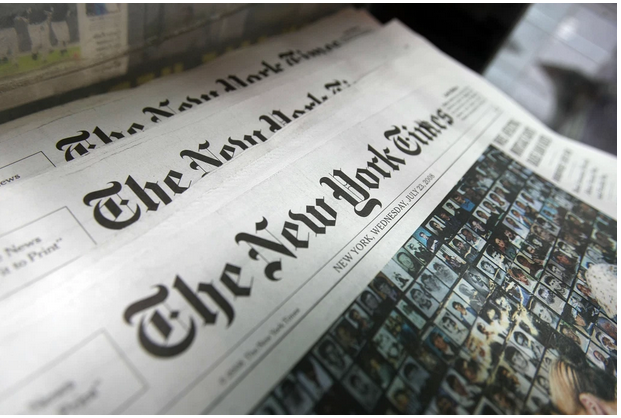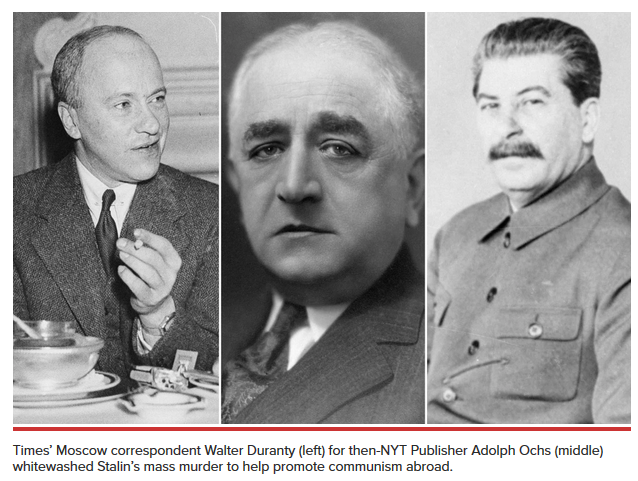How the New York Times has published lies to serve a biased narrative
8 min read
Original Article by The New York Post
April was the month the narratives died.
On April 15, the Biden administration acknowledged there was no evidence that Russia ever offered bounties on American troops in Afghanistan, walking back a report that wounded former President Donald Trump in the run-up to the 2020 election.
Four days later, the Washington, DC, medical examiner revealed that Capitol Police Officer Brian Sicknick had not been murdered by rampaging Trump supporters during the Jan. 6 Capitol Hill riot, as reports had claimed, but had died of natural causes.
Both stories were based on anonymous, unidentifiable sources, but had become deeply enmeshed in the public consciousness. Both confirmed the assumptions of the nation’s left-leaning media and academic elite, while damaging their political enemies.
And both were driven by The New York Times, where malicious misreporting has been the practice for a century, argues journalist and media commentator Ashley Rindsberg.
“My research churned up not mere errors or inaccuracies but whole-cloth falsehoods,” Rindsberg writes in “The Gray Lady Winked” (Midnight Oil), out now, which examines how the nation’s premier media outlet manipulates what we think is the news.
The “fabrications and distortions” he found in the Times’ coverage of major stories from Hitler’s Germany and Stalin’s Russia to Vietnam and the Iraq War “were never the product of simple error,” Rindsberg contends.
“Rather, they were the byproduct of a particular kind of system, a truth-producing machine” constructed to twist facts into a pattern of the Times’ own choosing, he says.

Rindsberg argues that Times reporters have followed the same playbook since the 1920s.
Star reporters cite fuzzily identified sources and make sweeping assertions to support a narrative aligned with the corporate whims, economic needs and political preferences of the patriarchal Ochs-Sulzberger family, which has helmed the operation since 1896, he writes. The chosen narrative, reinforced from multiple angles, is entrenched through a network of stories over time.
“We toss the term ‘fake news’ around as if it’s something whimsical,” Rindsberg told The Post.
“But creating what I call a false media narrative is really hard,” he said. “It takes coordination, deliberation, and a lot of resources. And there aren’t many news organizations that can do it.”
With close to $2 billion in annual revenue, the Times has the money, prestige, experience and stature to set the narratives that other news outlets almost invariably follow.
“When the Times breaks these stories, it’s wall to wall,” Rindsberg said. “MSNBC, CNN — everywhere you look, you’ll get that story.
“And with the Times, it’s never just one false claim,” he said. “They make a concerted effort over time that they dig into and won’t let go.”
The paper’s coverage of Adolf Hitler’s Germany in the decade before World War II is an early example of its narrative manipulation, Rindsberg writes.
So glowing was its picture of the regime that the Nazis regularly included New York Times reports in their own radio programs.
“That’s because the Times bureau chief in Berlin, Guido Enderis, was a Nazi collaborator,” Rindsberg said.
Under Enderis, bureau reporters won Pulitzer Prizes as they drew on Hitler’s propaganda to cover the 1936 Berlin Olympics and the 1938 Munich Conference, when Britain and France tried to appease the fuhrer by giving him a chunk of Czechoslovakia. Enderis even parroted the Nazis’ claim that Poland invaded Germany to spark the war in Europe in 1939, not the other way around.
A fed-up Times staffer back in New York, Warren Irvin, complained to publisher Arthur Sulzberger about the glaring bias.

“Sulzberger replied that they couldn’t replace Enderis because he just had too much access. He got too many good scoops,” Rindsberg said. “Then he threatened to sue Irvin for defamation” if he went public with his criticism.
Once the United States declared war in December 1941, American journalists in Berlin were rounded up, placed under SS guard, and interned for five months in an unheated, under-provisioned hotel outside Frankfurt — except for one.
“Enderis was allowed to remain at the Hotel Adlon in Berlin, a very posh hotel,” Rindsberg said — because of his “proved friendliness to Germany,” a Nazi Foreign Office bureaucrat wrote in an internal memo.
“And you know, when you look back at the reporting, they were right,” Rindsberg said. “He did a great job for them. He was worth it.”
The infamous behavior of the Times’ star Moscow correspondent Walter Duranty — who pooh-poohed reports of the Holodomor, the 1932-33 mass starvation that Josef Stalin either allowed or imposed in the Ukraine — is well known.
But Rindsberg’s book reveals that Duranty had not accidentally overlooked the disaster that killed millions.
“Duranty was instructed by his higher-ups to cover the Ukraine famine in that way,” Rindsberg said. “At the time, The New York Times was actively pushing for American recognition of the Soviet Union,” he explained. The US business establishment, led by the Chamber of Commerce, was on board, and Soviet rhetoric meshed with the Ochs-Sulzberger family’s leftist politics.
With the Times, it’s never just one false claim. They make a concerted effort over time that they dig into and won’t let go.
author Ashley Rindsberg, on how the Times distorts the news
Duranty personally shepherded the recognition effort, briefing soon-to-be President Franklin D. Roosevelt on the issue in 1932.

“You cannot convince the American public that this is a regime worth recognizing when it has just killed five million of its own people — even unintentionally,” Rindsberg said.
The Times got its way. With news of the Holodomor suppressed, Roosevelt formally recognized the USSR less than a year into his presidency. Duranty escorted Soviet Foreign Minister Maxim Litvinov across the Atlantic for his first US visit in 1933.
All along, historians would later learn, Duranty and the Times had been doing Stalin’s bidding.
Documents in the US National Archives record a 1931 conversation in which Duranty told a State Department official that, “ ‘in agreement with The New York Times and the Soviet authorities,’ his official dispatches always reflect the official opinion of the Soviet regime and not his own.”
Rindsberg sees the Sicknick and Russian-bounty stories as the latest examples of narrative construction at the Times.
Sicknick died the evening of Jan. 7, the day after Trump supporters overran the US Capitol.

“By Jan. 8th the Times had already published two big stories on his death,” Rindsberg said. “Right off the bat the narrative was that he’d been murdered.”
In those initial stories, “two law enforcement officials” claimed that Sicknick suffered a “bloody gash” when “pro-Trump rioters . . . struck him in the head with a fire extinguisher.”
“Pretty profound claims: that these people were not just protesting or rioting, but were committing murder — at the behest of President Trump,” Rindsberg said.
Over the next month, at least 20 Times articles pounded the theme that Sicknick had been “killed” by the demonstrators or died as a result of rioters’ violence. None of the reports named a source for the claim, or even identified the law enforcement body from which it originated.
“Ten or 12 different reporters contributed to this,” Rindsberg said. “Several had won Pulitzer Prizes” for coverage of the Trump-Russia narrative after the 2016 presidential election.
“Yet early on, the story was already changing,” Rindsberg said. “Within a few days, there were doubts.”
In February, the Times shifted gears to claim that Sicknick had been overcome by mace or bear spray — as references to his bloody head wound faded from view. Ten more stories followed, continuing to press the idea that Capitol violence had killed him.
Not until April 19 did readers learn that Sicknick sustained no injuries at all in the melee, but had died of an unrelated stroke.
“To the Times, Sicknick was the perfect symbol,” Rindsberg said. “A devoted police officer, by all accounts a good man, put in Trump’s crosshairs” — a fresh indictment of a president who, according to a much larger Times narrative, had been poisoning the American political system for his entire term.
“When a symbol fits their narrative, they just cannot let it go.”
Similar hallmarks can be seen in the Russian bounties story, which the Times launched on June 26, 2020, Rindsberg said.
“What they were reporting on was an intelligence assessment,” Rindsberg said, a government account that by its very nature is ambiguous and incomplete.
The assessment alleged that a Russian intelligence unit had offered bounties to Taliban-linked militias for killing American and other coalition troops in Afghanistan. But it included no corroborating details on who if anyone had been paid, how much was offered, or even the source of the disclosure.
Nonetheless, “the Times coverage quickly became conclusive,” Rindsberg said. Its initial story was framed in the most absolute of terms, claiming that “American intelligence officials have concluded” that bounties were offered — and that Trump had refused to take action on the information.
“It was circular logic: We know that Trump is colluding with the Russians, therefore he doesn’t do anything about the bounties,” Rindsberg said. “And why doesn’t Trump do anything about the bounties? Because we know he’s colluding with the Russians.”
Some of the paper’s top prize-winning reporters participated in follow-up stories that hammered on the theme for months, despite National Security Agency objections.
“When the NSA began questioning the reliability of the intelligence, the Times was very quick to downplay that,” Rindsberg said. “Immediately, the story became that Trump was pressuring the NSA to cast those doubts. Just like that, they’ve tainted the counternarrative.”
Ten months — and a presidential election — would pass before another media outlet, NBC, revealed that the initial intelligence had been “inconclusive” all along.
“CIA intelligence assessments never have been, never will be considered the gospel truth,” Rindsberg said. “You just cannot rely on them. The New York Times should have known that.
“But they did rely on it. The symbolism of the story was too good to give up.”
The damage wrought by such powerful yet false symbolism is profound, Rindsberg concludes.
“These narratives are interlocking,” Rindsberg said. “They have different nodes that connect to each other and strengthen each other in a network effect.
“Maybe you can knock down one piece of the story, but it doesn’t affect the bigger false narrative, because the network is so robust.”
And not even a retraction will dislodge it from our minds.
“We already believe Sicknick was battered to death, because we were told that for a month every single day,” Rindsberg said.
“And when the story turns out to be false, The New York Times does not do accountability,” he said. “It’s quiet little adjustments — updates to the Web pages, maybe run a small correction or an editor’s letter somewhere.”
After at least 30 Times stories and columns linked Brian Sicknick’s death to the actions of the Jan. 6 rioters, news that the medical examiner had punctured the narrative ran on page A12.
“Because they’re protecting the thing that is most valuable to them, their reputation,” Rindsberg said. “And doing it at the expense of the truth.”



